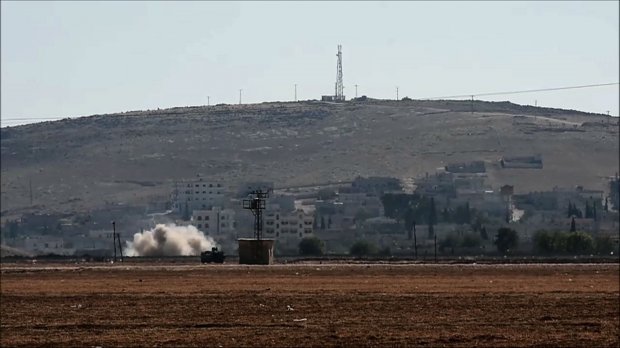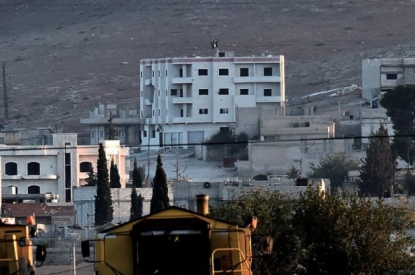Black flag over Kobane
PARIS, October 7, 2014 - Fighters keep watch under the black flag of the Islamic State group on a hill to the east of the Syrian town of Kobane.
AFP photographer Aris Messinis shot the picture early in the afternoon on Monday, October 6 from the Turkish village of Mursitpinar, just across the border.
Its unusual composition and the fact that the militants' silhouettes seem out of proportion to other elements led some AFP clients to call the agency to check it was real. Of course, it was.
"I took this picture from a group of houses that were around 500 metres north of the border," said Aris Messinis. "It's the closest we could get to Syrian territory without being driven away by the Turkish army, who are permanently on guard. From my position, the hill occupied by the IS fighters was slightly more than one kilometre away."
 The above image as shot by the photographer, before editing (AFP Photo / Aris Messinis)
The above image as shot by the photographer, before editing (AFP Photo / Aris Messinis)"The hill completely dominates Kobane. The militants set up some weapons there. They haven't moved since they raised their flag there on Monday afternoon. They were still there this morning (Monday October 7)."
Aris Messinis used a 400 mm telephoto lens and a focal length multiplier - a ring that can be screwed between the lens and the camera body and increase the focal length up to 600 mm.
It is equipment used by professional sports photographers to take pictures close to the action from the sidelines.

The very powerful lens flattens perspective, which explains the lack of proportion between the fighters on the top of the hill and the cars in the foreground.
The picture is also blurred by warm mist rising from the ground, which is visible in this video also shot by Aris Messinis.

The other oddity is the presence at the bottom of the hill of white shapes which look like a group of damaged buildings. If they were actually buildings they would be blatantly out of proportion with the silhouettes of the militants atop the summit.
"I'm not sure what they are," said Aris Messinis. "And I don't have any desire to go there to check it out!"
"It's perhaps some kind of ancient ruin or, more likely, a cemetery. When I zoomed in on my pictures I could see Arab writing on some sorts of pillars. In any case, it's definitely not destroyed buildings."
 Another Islamic State flag flutters on the roof of a building inside Kobane (AFP Photo / Aris Messinis)
Another Islamic State flag flutters on the roof of a building inside Kobane (AFP Photo / Aris Messinis)Other pictures taken from the same spot by photographers from other media (particularly the Associated Press news agency) show exactly the same components.
The inscription in large letters on the side of the hill, "Newroz," means "New Year" in Kurdish, which is celebrated on March 20. So it was likely there before the jihadists arrived.
Aris Messinis is a photojournalist based in Athens who has covered conflicts in Libya, Syria, Ukraine as well as riots in Greece and Turkey.
He's known for striking pictures that can be hard to believe. In October 2011, his surrealist picture of a Libyan rebel playing the guitar in the middle of an intense gunfight in Sirte provoked some incredulity before it won a Bayeux-Calvados Award for war correspondents.
 National Transitional Council fighters fire against Kadhafi's troops in Sirte, Libya, on October 10, 2011 (AFP Photo / Aris Messinis)
National Transitional Council fighters fire against Kadhafi's troops in Sirte, Libya, on October 10, 2011 (AFP Photo / Aris Messinis)

